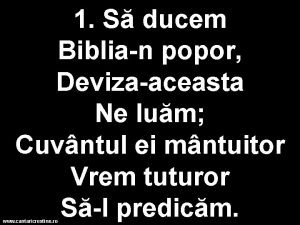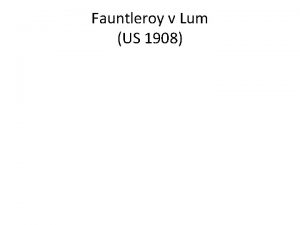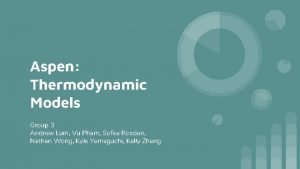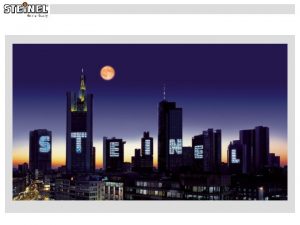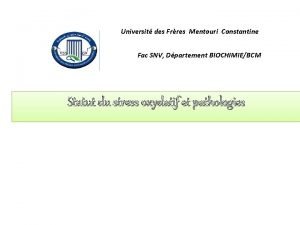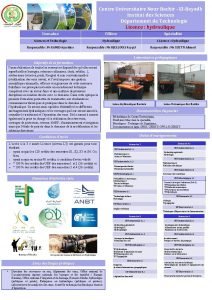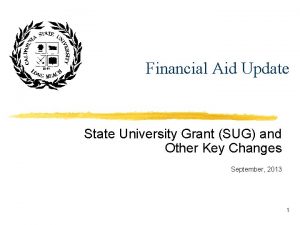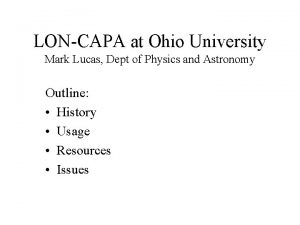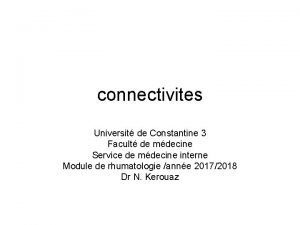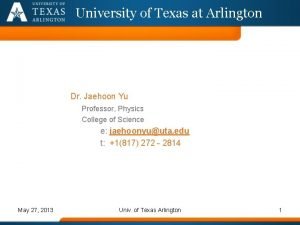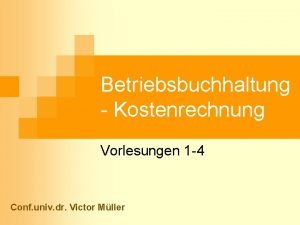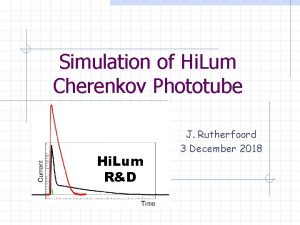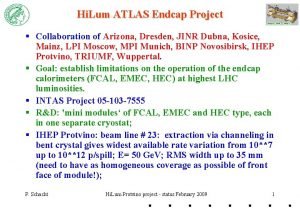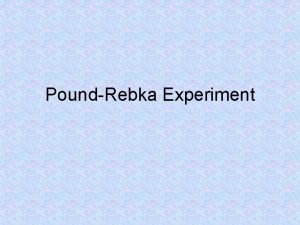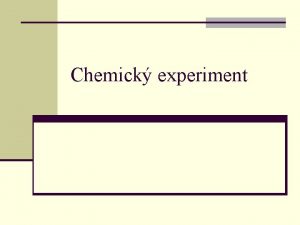Hi Lum Experiment Univ of Arizona Univ of














- Slides: 14

Hi. Lum Experiment Univ. of Arizona; Univ. of Dresden; JINR Dubna; IEP Košice; Univ. of Mainz; LPI Moscow; MPI Munich; BINP Novosibirsk; IHEP Protvino; TRIUMF Vancouver; Univ. of Wuppertal; Proposal: 2005 First Beam run: 2007 NIM papers: NIM A 669 (2012) 47, Second paper in progress Goal: establish limitations on the operation of the endcap calorimeters (FCAL, EMEC, HEC) at highest LHC luminosities 28 December 2021 Hilum Status February 2016 1

Analysis of EMEC HV currents EMEC (LAr gap of 2 mm) Preliminary Filter: Plateau flatness, 2 , correlation factor 28 December 2021 Hilum Status February 2016 2

Analysis of EMEC HV currents EMEC (LAr gap of 2 mm) Preliminary I 0. 75 EMEC: for I>Ic: I=Ic · (I/Ic)0. 75 expected with Ic ~ 1. 5 x 108 p/s; 28 December 2021 Hilum Status February 2016 3

Analysis of EMEC HV currents Preliminary EMEC (LAr gap of 2 mm) EMEC: for I>Ic: I=Ic · (I/Ic)0. 75 expected with Ic ~ 1. 5 x 108 p/s; 28 December 2021 Hilum Status February 2016 4

Analysis of EMEC HV currents: O. Novgorodova EMEC (LAr gap of 2 mm) Preliminary: average of both methods Ic = 1. 30 ± 0. 06 (stat. ) ± 0. 30 (sys. ) x 108 p/s p = 0. 728 ± 0. 004 (stat. ) ± 0. 005 (sys. ) But amplitude method is more appropriate Amplitude method: Ic = 1. 64 ± 0. 05 (stat. ) ± …. p = 0. 724 ± 0. 004 (stat. ) ± … 28 December 2021 Hilum Status February 2016 5

Analysis of EMEC Signal: A. Savin EMEC (LAr gap of 2 mm) Tint=20 ms; Colors indicate different beam impact positions; black corresponds to nominal center; 28 December 2021 Hilum Status February 2016 6

Analysis of EMEC Signal: J. Rutherfoord EMEC (LAr gap of 2 mm) expected EMEC 28 December 2021 Hilum Status February 2016 7

Analysis of FCal 250 Signal: A. Savin FCal (LAr gap of 0. 269 mm) Tint=2 ms; Colors indicate different beam impact positions; black corresponds to nominal center; 28 December 2021 Hilum Status February 2016 8

Analysis of FCal 100 Signal: A. Savin FCal (LAr gap of 0. 119 mm) Tint=2 ms; Colors indicate different beam impact positions; black corresponds to nominal center; 28 December 2021 Hilum Status February 2016 9

Analysis of HEC Signal: A. Savin HEC (LAr gap of 1. 97 mm) Tint=20 ms; Colors indicate different beam impact positions; black corresponds to nominal center; 28 December 2021 Hilum Status February 2016 10

From Hilum to ATLAS EMEC HV currents and signal confirm the model expectations; trusting the model, we expect for FCal(270) something like Ic = 8 x 109 p/s; We are not yet ready to fit the Ic knee from the signal dependence on prehistory intensity; but: results indicate that the FCal(270) signal is OK up to 1 x 1010 p/s ! We assume for the FCal at present Ic = 8 -10 x 109 p/s; In the hottest region FCal will be operated at HL-LHC at 80 V rather than 250 V (HV drop at 20 MΩ resistor); this will reduce the critical intensity to Ic= 0. 8 -1. 0 x 109 p/s; The HL-LHC prediction for a luminosity of 7. 5 x 1034 is I = 5 x 109 p/s for the hottest region; At r=5 signal amplitude is reduced by 33% (and Q by 55%) - in addition to due to the HV drop by up to 39% ; FCal(270) is affected in region η > 4. 1 (Andrej’s MC); Main advantage of LAr – stability of calibration – is gone (at high η ): dependence on luminosity; my best guess: jet acceptance will be reduced from η 4. 5 to η 4. 0; 28 December 2021 Hilum Status February 2016 11

Hilum s. FCal (HL-LHC option) with gaps of 119 µm and present FCal (269 µm) NIM A 669 (2012) 47 FCal option for HL-LHC FCal (119 µm) Present FCal (269 µm) 28 December 2021 Hilum Status February 2016 12

Hilum old results: EMEC and HEC NIM A 669 (2012) 47 EMEC HEC 28 December 2021 Hilum Status February 2016 13

IHEP U 70 accelerator and beamline #23: 50 Gev Protons Bunch: width 30 ns at 5%, about 15 ns FWHM; bunch spacing Δt=165 ns; IHEP U 70 accelerator runs specially in ‘debunching off mode‘, i. e. rf bunch structure is fully preserved! Accelerator runs specially only with 5 or less filled bunches per turn (out of 30), i. e. at least 1 μs between single (filled) bunches! Beam extraction via channeling in bent crystal technique → unique opportunity to cover range of intensities required from 106 – 1012 pps; but single bunch intensity measurement required!!! 28 December 2021 Hilum Status February 2016 14
 Lum jean monnet
Lum jean monnet Fauntleroy v. lum
Fauntleroy v. lum Peng robinson equation of state
Peng robinson equation of state Steinel hf-lum
Steinel hf-lum (univ. caxias do sul) escolha a alternativa que completa
(univ. caxias do sul) escolha a alternativa que completa Fs.univ.umbb
Fs.univ.umbb Snv constantine
Snv constantine Univ tln moodle
Univ tln moodle Centre universitaire el bayadh
Centre universitaire el bayadh Sug grant
Sug grant Lon capa ohio university
Lon capa ohio university Univ constantine 3
Univ constantine 3 Ut arlington va office
Ut arlington va office Kalkulatorische zinsen
Kalkulatorische zinsen Dr abou bekr
Dr abou bekr
